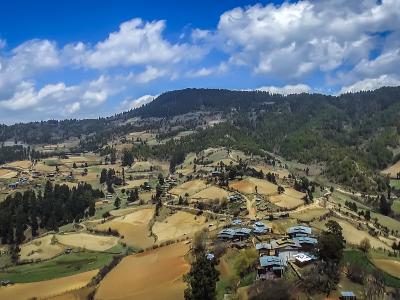The project Enhancing Sustainability and Climate Resilience of Forest and Agricultural Landscape and Community Livelihoods in Bhutan ('NAPA-III', 2017-2023) is operationalizing an integrated landscape approach in Bhutan by strengthening biological corridors, supporting sustainable forest and agricultural systems, and building the climate resilience of community livelihoods.
The project addresses concerns regarding the adverse impacts of climate change on rural livelihood security and poverty, and the effects of sector-led development practices on the ecological integrity of biodiversity-rich forested landscapes. Bhutan’s renewable natural resource (RNR) sector, which is made up of agriculture, livestock production and forestry forms a significant part of the national economy, as the largest employer with 58 percent of the working population, and with agriculture contributing 16.7 percent to the national economy in 2015. However, the RNR sector is very vulnerable to climate change impacts, which have been increasing as a result of heavy rainfall, drought, frost, hailstorms, windstorms and related land degradation.
In addition to climate-related losses, damage to crops and livestock from wildlife causes major production losses. Bhutan’s biodiversity resources are of regional and global significance and the preservation of intact, forested landscapes through the protected areas network and associated biological corridors is needed to sustain these values. However, climate change impacts and other anthropogenic threats such as land conversion, forest fires, infrastructure development and unsustainable agriculture are placing increasing pressure on biodiversity and the integrity of ecosystems in the country.
The long-term solution envisaged by the project is to ensure the effective climate resilient management of forest areas including biological corridors and adjoining protected areas, securing ecosystem services that underpin livelihoods, local and national development and climate change adaptation (CCA). However, there are several barriers that need to be overcome: 1) Insufficient institutional capacity for integrated landscape management (ILM) and CCA; 2) Insufficient capacity to operationalize the biological corridor system; 3) Limited capacity, awareness and support for building livelihood resilience; and 4) Inadequate knowledge on natural resource status, ecosystem services and resilient livelihood options.
Expected outcomes
Outcome 1: Enhanced institutional capacity for integrated landscape management (ILM) and climate change resilience
Outcome 2: Biological corridor (BC) governance and management established and demonstrated with management linkage to adjoining PAs.
Outcome 3: Livelihood options for communities are made climate-resilient through diversification, SLM and climate-smart agriculture and supported by enhanced climate-resilient infrastructure.
Outcome 4: Knowledge management system established to support sustainable management of forest and agricultural landscapes and climate-resilient communities.
Project details
Levels of intervention
- Community
- District
- National
Key implementers
- Country Office
- National Governments
- United Nations Development Programme (UNDP)
Funding amounts
Project partners
- Global Environment Facility (GEF)
- United Nations Development Programme (UNDP)
Introduction
The project Enhancing Sustainability and Climate Resilience of Forest and Agricultural Landscape and Community Livelihoods in Bhutan ('NAPA-III', 2017-2023) is operationalizing an integrated landscape approach in Bhutan by strengthening biological corridors, supporting sustainable forest and agricultural systems, and building the climate resilience of community livelihoods.
The project addresses concerns regarding the adverse impacts of climate change on rural livelihood security and poverty, and the effects of sector-led development practices on the ecological integrity of biodiversity-rich forested landscapes. Bhutan’s renewable natural resource (RNR) sector, which is made up of agriculture, livestock production and forestry forms a significant part of the national economy, as the largest employer with 58 percent of the working population, and with agriculture contributing 16.7 percent to the national economy in 2015. However, the RNR sector is very vulnerable to climate change impacts, which have been increasing as a result of heavy rainfall, drought, frost, hailstorms, windstorms and related land degradation.
In addition to climate-related losses, damage to crops and livestock from wildlife causes major production losses. Bhutan’s biodiversity resources are of regional and global significance and the preservation of intact, forested landscapes through the protected areas network and associated biological corridors is needed to sustain these values. However, climate change impacts and other anthropogenic threats such as land conversion, forest fires, infrastructure development and unsustainable agriculture are placing increasing pressure on biodiversity and the integrity of ecosystems in the country.
The long-term solution envisaged by the project is to ensure the effective climate resilient management of forest areas including biological corridors and adjoining protected areas, securing ecosystem services that underpin livelihoods, local and national development and climate change adaptation (CCA). However, there are several barriers that need to be overcome: 1) Insufficient institutional capacity for integrated landscape management (ILM) and CCA; 2) Insufficient capacity to operationalize the biological corridor system; 3) Limited capacity, awareness and support for building livelihood resilience; and 4) Inadequate knowledge on natural resource status, ecosystem services and resilient livelihood options.


Project details
The primary rationale for the selection of the project landscapes in the central belt of the country is based on the need to strengthen the ecological network connecting protected areas in the northern third of the country with those in the centre and south of the country – in other words, biological corridors that generally follow the alignment of river valleys and intervening ridges. This is of great importance for key wildlife species such as the tiger, leopard, snow leopard and elephant with large ranges. In particular, Bhutan is regarded as key source population for the tiger across the Himalayan range and this project will be of great significance in supporting national and global tiger recovery plans.
The project landscapes contain some of the finest representational samples of a continuum of ecosystems, connecting the largely subtropical zone of southern Bhutan and the predominantly sub-alpine/ alpine zone of northern Bhutan. These landscapes, with proper conservation management plans in operation and sustainable livelihoods in practice, will cushion the adverse impacts of climate change to key development sectors and local livelihoods and enhance the ecological resilience to changing climate and associated risks.
The primary global environmental benefits that will be delivered include the mainstreaming of biodiversity and ecosystem service conservation and climate change resilient livelihoods over a landscape of 1,304,958 ha, some 75.3 % of which is under forest cover, 9.7% shrub cover, a mere 1.6% agricultural land (due to the rugged terrain), and the remainder meadows, rocky terrain and snow 13.4%. 176,400 ha lies in the four BCs and 324,405 ha in the three associated PAs, thus totalling 500,805 ha of land within the national protected areas system (including the BCs). This far exceeds the PIF target of 350,000 ha of globally significant landscapes under improved management.
The project’s climate smart agriculture and sustainable land management interventions will target SLM practices in at least 2,000 ha (some 10% of the agricultural land within the project landscapes), and SFM implementation will be supported over at least 100,000 ha of FMUs, LFMP areas and CF areas within the landscapes, in line with the PIF target. Sustainable forest management and forest conservation is anticipated to result in avoided GHG emissions of some 3,578,372tCO2 eq over 10 years, exceeding the PIF target of 3,084,953 tCO2 eq.
- Community
- District
- National
- Country Office
- National Governments
- United Nations Development Programme (UNDP)
- Global Environment Facility (GEF)
- United Nations Development Programme (UNDP)
News
'Climate-resilient agriculture scheme helps revive rice cultivation in Sergithang Gewog, Tsirang', UNDP Bhutan, December 30, 2019
‘Protect landscapes to protect everything’: Bhutan announces national push for climate resiliency and conservation, UNDP Bhutan, November 11, 2017 Bhutan.
'Enhancing sustainability and climate resilience: UNDP and Gross National Happiness Commission sign Least Developed Countries Fund-financed project' , Kuensel Online, October 31, 2017.
'UNDP-GEF to help Bhutan look beyond the climate-environment realm', ReliefWeb, December 14, 2016
Key results & output
The project components can be summarized as follows:
Outcome 1: Enhanced institutional capacity for integrated landscape management (ILM) and climate change resilience: this component will focus on building institutional capacities for ILM as well enhancing climate resilience across rural communities. Specifically, it will incorporate biodiversity conservation objectives and safeguards and climate change concerns in the land use and natural resource use planning and management process, aiming to catalyse an economically and ecologically optimal land use mix and practices in the biological corridors and neighbouring landscapes.
Outcome 2: Biological corridor (BC) governance and management established and demonstrated with management linkage to adjoining PAs: this component will enable the RGoB to operationalize four BCs in the project landscapes through the development of climate-smart conservation management plans and the development of technical capacity and basic infrastructure, including strengthened biological monitoring and law enforcement systems and human-wildlife conflict management interventions to address threats including encroachment and poaching in conjunction with adjoining PAs in the project landscapes.
Outcome 3: Livelihood options for communities are made climate-resilient through diversification, SLM and climate-smart agriculture and supported by enhanced climate-resilient infrastructure: this component supports communities and service providers to enhance climate resilience of livelihoods by optimizing and diversifying production, adding post-production value and improving sustainable access to markets. In addition, it will demonstrate how climate change adaptation and biodiversity conservation as well sustainable forest management objectives can jointly be addressed, creating synergistic impacts for sustainable local development.
Outcome 4: Knowledge management system established to support sustainable management of forest and agricultural landscapes and climate-resilient communities: through this component, the project will ensure that information and knowledge accumulated and produced within the project will be documented and made available for wider communication and dissemination of project lessons and experiences to support the replication and scaling-up of project results.
Reports & publications
Videos & multimedia
Links
Newsfeed
Contacts
- UNDPManas MogheTechnical Specialist, Climate Change Adaptation










